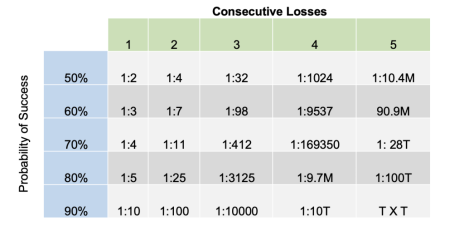Proper Position-Size in Options Trading
It doesn’t matter if you are just starting or have an advanced grasp of all things options, if you don’t think of yourself as a risk manager first, you will fail, it’s just a matter of time.
Proper risk management is what separates those that succeed from those that continually struggle or simply just give up.
What people continue to struggle with is trying to find the latest and greatest strategy, constantly hopping from one strategy to the next. Strategy is far less important, than proper risk management.
[text_ad use_post='261460']
Placing trades, well, it’s the easiest part of the trading process. Anyone can place a trade. It’s how you handle the trade that allows you to be profitable over the long term.
Which is why you MUST think of yourself as a risk manager first, especially if you are taking a truly quant-based approach. The law of large numbers is your foundation but managing sequence risk is the obstacle that most traders just can’t overcome.
Sequence risk is the inherent risk that a trader could suffer multiple losses in a row. The best way to combat sequence risk is through proper position sizing. Position sizing mitigates the impact of consecutive losses. The lower the capital risked per trade, the lower the probability that a sequence of losing trades will cause a significant drawdown.
The table below shows how sequence risk can impact your overall account and why it is imperative that you use proper position size when investing/trading.
Again, we know losing trades are going to occur. It’s a hard fact that we must accept. So, trades must be managed appropriately. And the first step is proper position size.
The most important decision you will make as a successful options trader is how much to allocate per trade. From a risk-management standpoint, maintaining a consistent position size among your trades is of the utmost importance. We want to limit the havoc that one trade could have on our portfolio.
For simplicity’s sake, let’s say our trading account stands at $10,000 in this example.
In one case, we have allocated 50% per trade. In the other, we have allocated 5% per trade.
$10,000 Account (50% allocated per trade):
One position, equally weighted at $5,000. So, with each trade, a 10% drop will cause a 5% drop in our overall portfolio. A 20% drop will cause a 10% drop, 30% would be 15% . . . you get the picture.
Just knowing this gives every options trader the insight necessary to shape a position size and stop-loss strategy for maximum effectiveness.
Let’s say with each trade we set our stop-loss order at 50% of our allocated amount. For example, with 50% allocated to each trade, out stop loss would be set at $2,500.
Two trades would only allow us to diversify among two positions with 50% of our overall portfolio value at risk.
$10,000 Account (5% allocated per trade):
One position, equally weighted at $500. So, with each trade, a 10% drop will cause a 0.5% drop in our overall portfolio. A 20% drop will cause a 1% drop, 30% would be 1.5% . . . again, you get the picture.
Our stop-loss with 5% allocated per trade is $250.
For example, if we had four iron condor trades open simultaneously, we would have $2,000 in play with only $1,000 or 10% of our overall portfolio at risk.
Worst-Case Scenario
If we assume our position size of $500 per trade and had four trades going at one time, our maximum loss is 10% or $1,000 of our overall portfolio.
A 10% loss in the portfolio would need a 11.11% overall gain to make up for the loss.
Summary
I realize the prior exercise is fairly simplistic. Again, it only begins the important discussion of money management. Without some form of money management, emotions take over.
And emotions are the enemy. Hindsight never exists in the present. We must realize that we will be wrong on occasion.
Being privy to this allows us to prepare accordingly. We know over the long term that having a defined stop loss will only serve to benefit the performance of our respective portfolios. More importantly, we always know when to sell. Of course, all of the above assumes that we prefer the straight percentage stop-loss.
If you want to be a successful trader/investor over the long term, then taking the time to figure out an appropriate position-sizing plan is imperative. Please, please, please do not overlook this important concept.
You will not regret it.
As always, if you have any questions, please do not hesitate to email me or post a question in the comments section below. And don’t forget to sign up for my Free Newsletter for weekly education, research and trade ideas.



